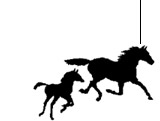|
Letter to Editor of MacLean
by Denise Lockhart
Published in MacLean's:
RE: HORRORS, IT'S LIKE EATING YOUR DOG! By Pamela Cuthbert, July 9/09: While Ms. Cuthbert's article does touch on the issues surrounding the controversial industry of horse slaughter, there are compelling reasons to argue that horse slaughter and horsemeat consumption, should be an unacceptable practice in our country. I would like to correct and clarify some of the errors in her article.
Horses that enter the slaughter pipeline are not necessarily ex-racehorses or old workhorses; the bulk of the horses are seven years of age or younger and in good health. Kill buyers do not want the sick or aged horse for the simple reason it is far more lucrative (and the meat is far more tender) to buy young stock. Kill buyers obtain their product from many sources in Canada: from the U.S. (in 2008 over 113,000 horses were killed in Canadian facilities); local rural and urban auctions, breeding and racing establishments, private farms and the PMU industry, to name but a few. Statistics released by the Animal Welfare Institute show that over 92% of the horses arriving at slaughter plants were deemed to be in good body score condition i.e. neither old nor infirm. While it is true the U.S. shuttered its slaughter facilities in late 2007, it remains a tri-country industry: the U.S. ships its horses northward to Canada or southward to Mexico. In Canada, we slaughter in largely foreign-owned facilities using our federal jurisdictions to inspect the meat, to foreign countries. Federally, neither the U.S. nor Canada has any laws governing horse slaughter to date. The closing of the U.S. slaughter plants was a state-by-state legislation. While anti slaughter agitation certainly helped to crack open the horrific slaughtering process in the U.S., politically it was the lack of money to oversee the slaughter facilities that signaled the death knell.
Enter Canada. Foreign-owned investors looked north of the border to set up a compliant and profitable business. Demand for horsemeat in Europe was at an all-time high, largely due to BSE (mad cow disease) and European markets were thriving and continue to flourish. Meanwhile, in Canada, our overseeing agricultural body, the Canadian Food Inspection Agency (CFIA), was proving just as inept as its U.S. counterparts. In 2008, violations were exposed by the CBC in conjunction with the Canadian Horse Defence Coalition (CHDC) proving that the CFIA's mandate to adequately provide and ensure all horses receive humane treatment at the slaughter facilities was seriously eroded. Under intense media scrutiny, the most notorious of these plants in Neudorf, Saskatchewan, closed its facilities early this year. This resultant closure took months of diligent investigation, sometimes surreptitiously, by the CHDC.
Recently, the European Union (EU) has called on a ban of horsemeat citing concerns over its safety. "From a good health standpoint" no reputable chef would dare consider serving "cheval" in Canada: the numerous drugs found in horsemeat from the most benign phenylbutazone, a popular analgesic painkiller, to the powerhouse steroids administered to some racehorses, can prove deadly for human consumption. To date, there are no adequate detectors to ensure the safety of horsemeat and, while we as a nation do not consume horseflesh per se, we unwittingly export contaminated product overseas to naive and gullible Europeans. Food chain livestock in Canada and the U.S. are required to meet Health Canada and FDA standards before they can be considered safe to eat. As horses are not considered a food chain animal, there are no guidelines in place that completely ensure horses slaughtered in Canada are free from drug contaminants and disease.
The "growing movement" supported by the American Veterinary Medical Association (AVMA) that Ms. Cuthbert cites is part of a very large and very vocal pro slaughter stance funded in part by various aggregate cattlemenÃÂÃÂs associations in the U.S. This powerful lobby group with very deep pockets continually perpetuates the myth of the "unwanted" horse to satisfy their own ends. The AVMA, in conjunction with the American Horse Council (AHC) and the American Quarter Horse Association (AQHA) are the largest proponents of the pro slaughter movement in the U.S. Ms. Cuthbert should keep in mind that economic gain fuels all aspects of the horse slaughter issue and profit is the bottom line, not the cozy and fuzzy issues as the humane slaughter of the "unwanted"ÃÂÃÂ surely a misnomer if ever there was one.
To "repurpose" horses as food, either in our own cultural milieu or to satisfy diners overseas is virtually impossible, but there are those that will try. The sacrifice in this treacherous game, the ennobled horse to which we owe so much through our ascent as a civilization, is merely an innocent pawn.
Sincerely,
DENISE LOCKHART
"Help us lead Canada's horses away from barbarism . .
and into the protected pastures of a civilized
nation."
|


